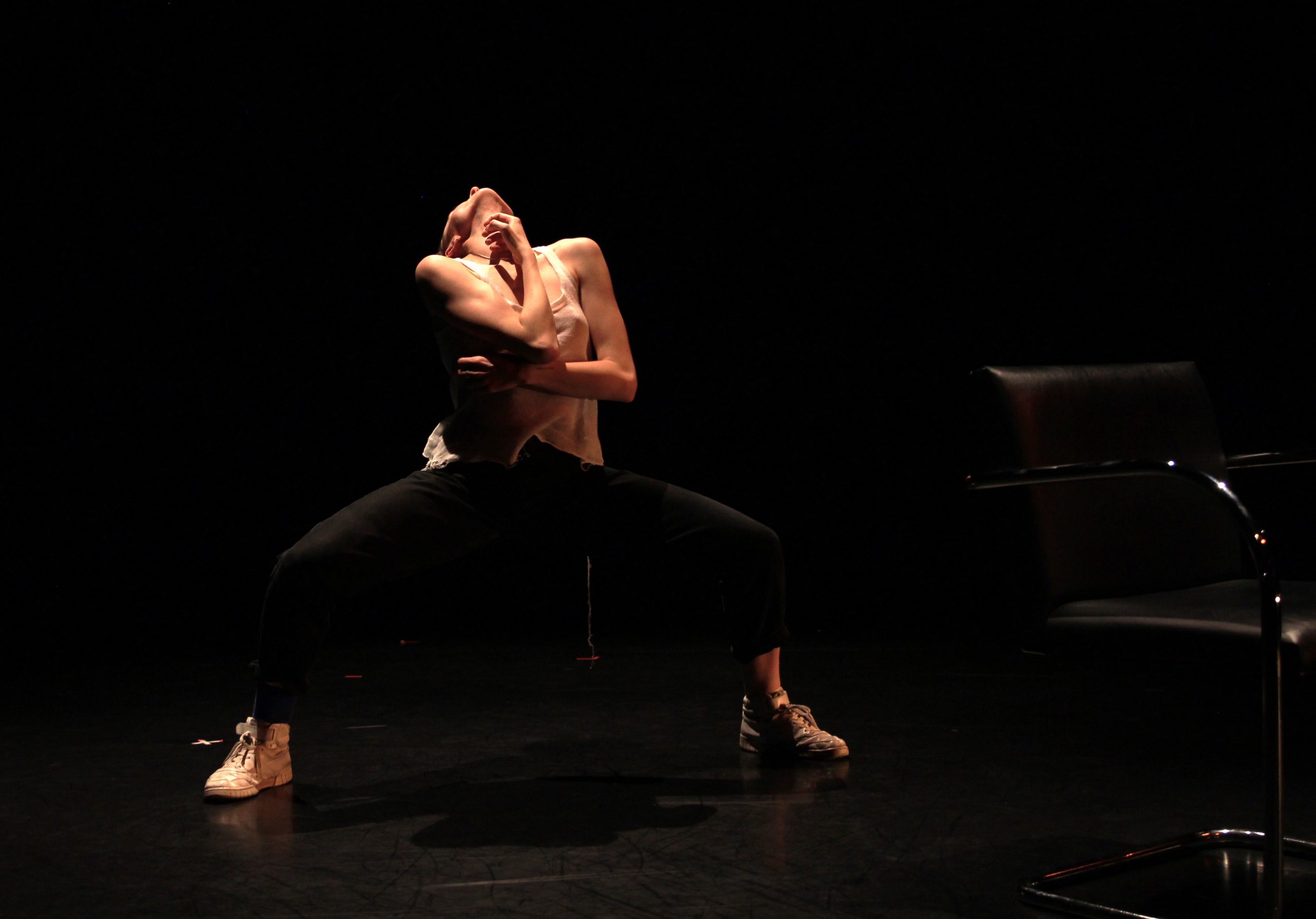A light breeze of patchouli wafted throughout the Wellspring Theater as the lights rose on Friday evening for the second of four professional short works programs curated for RADFest’s 2023 season.
Bent at the waist, head dropped, Alice (Al) Svetic windmilled their arms forward until the turbulence lifted their oversized, striped button down shirt. They stood with breasts bare and sternum jutting boldly back at the audience. “Histories,” Svetic’s self-choreographed dance diary, opened a queer past for inspection. Cutting the air with their sinewy limbs, Svetic stirred recollections of pleasure, desire, shame, introspection and hope. Rolling their wrists in homage to vogue, Svetic shimmied and grooved to the minimalist harmonica-sprinkled house beat of Lizzy Mercier Descloux’s “Hard-boiled Babe.” This celebration of joy and pleasure quickly morphed into dark fantasy as Svetic descended slowly along the downstage right diagonal toward the edge of a pool of light housing an empty chair. Behind the chair Svetic closed their eyes, arching and grinding against an invisible someone. Their pelvis rocked, their movement hot, breathy and thick. The chair remained staunchly in place, facing away from action as if averting its gaze.
Dennis Davis rippled fluidly through Carolyn Pampalone Rabbers’ duet, “INtightSPACES.” In a mesh black top and dark slate pants, he rolled loosely onto the sides of his supple feet. Without using his hands for leverage, he sprung from the floor into a deep second position plie, arcing seamlessly into a full backbend. Accompanied by Flore Laurentine’s haunting, atmospheric music, Davis gently swiped at the air, encircling an absent partner. Though recognizable, the subtlety of this gesture avoided camp. For me, Pampalone Rabbers’ intention to “explore the nuances of restriction and freedom in complex relationships” would have read more potently if the dance had remained a solo. Rabbers’ own entrance, marked by angular shapes, high legs and fast feet, interrupted the aching atmosphere she had so carefully crafted in the first section of the work.
Like an overzealous boss, Elizabeth Shea’s “Rhythm Runs Through It” used volume to try and command attention. Dressed in a navy boiler suit, Kate Vermillion Lyons tramped onto the stage, hoisting a folded plastic table. I knew she was going to unfold the table and slam it down aggressively. She did. Rachel Nubrough later followed suit with a second table. Drawing upon industrial imagery, Vermillion Lyons and Nubrough forced their way through the third shift. Circling, eyes locked, hands slamming tables, the pair danced—loudly. The pounding felt forced, their stomping and additional table slamming competing against the rich rhythms of Steve Reich’s “Drumming (Four Tet Remix).” The dissonance distracted me from the dance. Fortunately, a mishap caused a moment of excitement. Nubrough jumped horizontally onto one of the tables, the center of which promptly buckled. She navigated this moment with finesse, troubleshooting in real time as one would in an actual machine shop. For the rest of the dance, this table remained caved in. The malfunction forced the dancers to transition from rote performance to on the spot strategizing, leaving the dance in a slightly more interesting place than it started.
Shirtless, and covered in gold glitter, Aly Keita surveyed his surroundings. His work, “Djata: Conversations of the Manden,” embodied the story of Soundjata, a prince who was crippled as a child and later rose up to unite the Mandingo Empire. As the story goes, after watching his mother face years of merciless public ridicule for her son’s condition, Soundjata decided he would do everything in his power to learn to walk. Keita transformed this tale from oral tradition to physical encounter. He progressed patiently through sections of the dance that took him from seated, to lying down, to crawling, hand balancing and eventually dancing upright. His circus background and athletic chops were evident, performing consecutive jumping barrels with ease and tossing himself back and forth from his feet to his hands with evident stamina. Though the work felt too long for me, the duration underscored the arduous task of fighting adversity through persistence. One of the highlights of this dance was Keita’s impressive use of body music. He orchestrated polyrhythm with prowess, keeping time with a suite of stamps, claps, pats and vocal clicks. While some of the transitions between physical tasks felt unfinished, the precision and excitement of the sonic experience never wavered.
I was grateful for a moment to stretch my legs while walking across the hall to the Judy K. Jolliffe Theatre for a peek into Kate Corby and Emily Miller’s “Terrarium.” Seated in an intimate horseshoe, the audience outlined a metaphoric tank for soloist Lauren John, who tenderly rippled in the center of a single light cast from above. At home in the mirco-abyss, her swinging arms, whipping turns and delicate gestures painted the picture of a reptile going about its business. Her home squeaked and crackled with the distant sounds of a Nat Evans’s ecoscape. John’s prowess in articulation—her ability to roll back and forth with the same intricacy as moving a single finger—brought me a sense of calm. John seemed unbothered by the audience. She curled on the floor for a nap in the warmth of her sunlamp. There was exquisite intimacy in this fortress of solitude.
—
A virtual encore of all four RADFest professional series programs and the youth showcase will be available for online audiences March 10-12. Tickets at midwestradfest.org.
